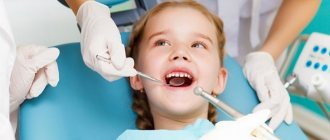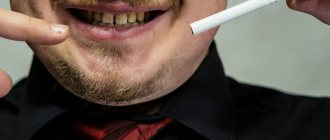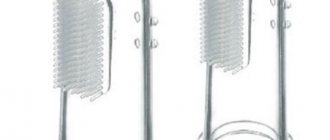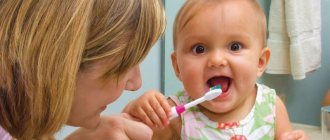The first signs of yellow teeth may appear in a child with the appearance of the first molar. At this stage, parents should be careful and seek advice from a pediatric dentist. If you exclude all factors that influence the darkening of tooth enamel, then it is quite possible that you will be able to correct the natural tone of the tooth enamel of growing teeth. These are the factors.
- Insufficient oral hygiene. If you don't supervise your baby and brush twice a day daily, plaque buildup can negatively impact the shade and formation of your baby's yellow molars.
- Correction of baby food. If a child consumes large quantities of coloring juices (carrots, pomegranates, cherries), pigment may be deposited on the hard tissue of the teeth. If the tint does not disappear within a day, then it is better to exclude such “natural” juices from your baby’s diet. The consumption of sweet and flour products is also important. It is sometimes difficult for a child to refuse sweets, but consuming sweets too often can directly affect the color of tooth enamel. Carbohydrates are a breeding ground for pathogenic bacteria, which produce acids during their life. It is these acids that destroy tooth enamel.
- Taking tetracycline antibacterial drugs. Certain medications can affect the color of enamel. This applies to both the use of medications by the baby himself and the use of medications by the mother during pregnancy. If the first signs of darkening appear during treatment of a child, you should consult a doctor and, possibly, replace the drug with another group of antibiotics.
- Enamel hypoplasia. Only the thin coating of the crown—tooth enamel—has a milky white color. Beneath it are darker tooth tissues - the so-called dentin. It is the translucency of dentin that causes the yellowish or bluish tint. If the enamel layer is insufficient, which sometimes happens in children as a pathology, then the dentin shows through quite strongly, and the teeth acquire a dirty yellow tint. It is not always possible to eliminate this fact. The dentist may prescribe an additional calcium supplement for your baby to support the development of tooth enamel. However, this is not a radical measure, so it is worth waiting until the child’s dentition is fully formed and then choosing a correction method.
- Poor quality drinking water. Large amounts of iron in water can cause yellowing of the enamel. If this situation occurs among all residents of a given region, then special purification filters for drinking water should be purchased. Otherwise, your child will have to put up with yellow teeth.
- Changes in enamel color while wearing braces. Correcting a child’s bite is a necessary and very important event. However, enhanced hygiene should be especially carefully monitored during this period. Plaque forms in the places where the braces are attached, which cannot be cleaned with a regular toothbrush and can form a yellow stain on a child’s tooth. This can lead to darkening of the enamel or even the development of dental caries. You can cope with this problem using a special irrigator designed for cleaning teeth in hard-to-reach places. Or you can visit a dentist and have your mouth professionally cleaned.
- In rare cases, yellowing of teeth can be a consequence of a general illness in the child's body. Diagnoses such as hepatitis, fluorosis, kidney disease, and serious metabolic disorders can provoke changes in the structure of the hard tissues of the teeth. In this case, the question is more about treating the root cause than its consequences.
Is yellowness normal or pathological?
Not every yellowness should be perceived as a deviation from the norm. Sometimes, due to hereditary factors, a child’s enamel becomes more transparent than that of other children. The lack of white pigment causes the dentin to show through, resulting in darker teeth.
Some dentists are inclined to believe that it is better not to correct or whiten such enamel. At least until the child reaches adulthood and hard tissues are fully formed.
If yellow teeth are showing signs of health, the best thing you can do for your baby is to practice good oral hygiene and good nutrition.
My child’s teeth have turned yellow – what should I do?
Very often, pediatric dentists hear from parents that their child’s teeth have turned yellow . Of course, this makes you worry and directs you to search for useful information on the Internet and books. For what reasons does this problem occur and is it possible to somehow fix it?
Insufficient dental care is the first reason why a child’s teeth turn yellow
One of the main reasons for the appearance of yellow plaque is the consumption of tea and other drinks that can stain the teeth. Good, proper oral hygiene will help to cope with this problem. It is advisable while the child is small that his parents brush his teeth, and for older children who brush themselves, this procedure is monitored. Poor dental care can cause yellow stains on your teeth. Particular attention should be paid if the child has orthodontic structures in his mouth. As a rule, their presence prevents you from cleaning your teeth well, so it is recommended to periodically have them cleaned by a dentist.
The child's teeth have turned yellow due to thinning tooth enamel
The next reason why a child's teeth turn yellow is thinning of the tooth enamel or its chips. Enamel is the membrane that covers the tooth. In addition to its protective properties, it also gives whiteness to both children’s and adult teeth. Beneath it is dentin, which by its nature has a yellowish tint. Depending on many reasons (for example, drinking carbonated drinks), it becomes thinner, and dentin begins to show through the enamel. As a preventive measure, it is worth limiting the consumption of carbonated drinks and brushing your teeth carefully with a soft toothbrush.
Medicines are the third reason why a child’s teeth turn yellow
Taking various medications can also negatively affect the color of teeth. For example, antibacterial drugs can give a yellow tint to teeth not only after being taken directly by the child, but also if the mother took such medications while pregnant. In addition, scientists have established a relationship between the mother’s teeth during pregnancy and the condition of the child’s teeth. Therefore, during pregnancy, a woman can take some measures to avoid problems with her own child’s dental health in the future. Firstly, try not to take antibiotics without acute indications. Secondly, take enough vitamin C (thanks to it, tooth enamel becomes strong). Thirdly, take foods that contain fluoride and phosphorus (most dental problems arise precisely because of their insufficient quantity).
At the same time, various intrauterine disorders may be the answer to the question of why the child’s teeth turned yellow . Especially if these violations occurred at the stage of formation of the rudiments of teeth. This problem often occurs in children who suffered from jaundice during the neonatal period. The shade acquired by the teeth in this case can be completely different, ranging from brown to greenish. Sometimes congenital diseases such as dentinogenesis imperfecta or amelogenesis imperfecta also lead to discoloration. Fortunately, such diseases are quite rare.
Very often, parents do not attach importance to the problems associated with their child’s baby teeth. However, it is worth remembering that the unresolved cause of dental disease in childhood can spread to permanent teeth. In this case, sometimes much more serious dental treatment may be required.
22.02.2013 23:54
Rules for children's dental hygiene
The first oral hygiene procedures begin after the baby has cut his first tooth. During this period, the brush is not yet used, and the gums are wiped with a damp cloth. When several teeth erupt, you can begin hygiene with the help of a special baby brush. It should be very soft and delicately clean the delicate surface of children's teeth. When a child reaches 2.5 years of age, he is taught to practice brushing independently, at first without toothpaste. When the baby masters this procedure, you can use special baby pastes, which are designed for the fact that the baby has not yet learned to spit out the paste and will periodically swallow it. Children's pastes should be free of dyes, flavorings and fragrances.
How to deal with yellow teeth?
On a note! If yellow plaque is detected, it is recommended to immediately contact a specialist. Moreover, it is necessary to visit the dentist for up to a year, even if nothing bothers the child.
There are several ways to whiten teeth
The doctor will definitely find out what causes the yellowing of the enamel, tell you how to properly care for the oral cavity, and advise the most suitable method of teeth whitening.
Table. Comparison of the main whitening methods.
| Name, photo | Short description |
| Mechanical cleaning | A baby over one year old can already brush his teeth using a small amount of toothpaste that contains fluoride. When your child learns to clean them himself, be sure to monitor how well he does it. But if the teeth have become persistently yellow, then no hygiene procedures will help - professional cleaning using dental equipment will be required. |
| Ultraviolet irradiation | If the cause of yellow discoloration is the use of antibiotics, then the problem can be corrected by visiting a physical therapist. Thanks to UV irradiation, which has a destructive effect on the antibiotic, the color of the enamel can be restored. But the irradiation procedure itself can only be prescribed by a doctor after the connection between yellowing and drug therapy has been accurately established. |
| Special means | To remove plaque on baby teeth, you can use special rinses and ointments. These can be such products as “Remodent”, “Gluflutored”, “Boding”, “Monobond Plus” and others. In addition, thinned enamel needs to be strengthened, for which the teeth are silvered or coated with fluoride varnish. |
| The use of folk remedies | You should not use traditional methods to whiten children's teeth. It is only allowed to give the baby fresh apples, wipe the front of the teeth with lemon peel and rinse the mouth with water with a small amount of lemon juice added. When rubbing, by the way, the gums are also massaged, thanks to which they become stronger. |
Teeth whitening for a child - before and after photos
Whitening pastes
Such pastes and gels can be freely purchased in pharmacies, or ordered on the recommendation of your doctor. It is not advisable to use them constantly, since they still have some effect on the enamel. It is best to periodically alternate whitening compounds with medicinal or gum strengthening ones.
With your dentist's approval, you can try home whitening using trays and whitening gels. Such procedures can significantly change the tone of tooth enamel towards white. However, you should not get carried away with this method, since it increases tooth sensitivity and, if used incorrectly, can damage tooth enamel.
Yellow teeth: what to do and how to whiten yellow teeth
Almost all owners of yellow, dull enamel are interested in how to whiten yellow teeth. Some resort to traditional medicine methods, others to various chemical whitening procedures. However, it should be remembered that before you whiten yellow teeth, you need to find the cause of this problem.
If external factors (smoking, consumption of coloring drinks and foods, occupational hazards) have caused a problem such as yellow teeth, what to do is absolutely clear!
First of all, you need to remove the provoking factor - without this, no treatment will save your yellow teeth. What to do if there are internal reasons? If these are somatic or dental diseases, their treatment comes first.
Special diet
It is believed that apples and raw carrots are the best teeth cleaners. These products perfectly remove plaque and supply a huge amount of useful substances to the body. Therefore, you should not limit yourself to them.
The LeaderStom network of clinics offers the services of the best pediatric dentists in Moscow. If you seek professional help in time, the condition of your child’s teeth can be correctly corrected with a course of treatment or preventive measures. Experienced therapists and orthopedists will help eliminate pathological yellowness of teeth and straighten your baby’s bite if indicated. Contact us, we are always ready to help.
A few more words about yellow teeth in babies
First of all, the baby needs to be shown to the dentist. He will find out why this happened and give practical advice regarding further actions.
Important! Children can use a special remineralizing gel. For preventive purposes, you can also brush your teeth with special wipes (sold in almost all pharmacies) or a silicone finger tip.
Finger brush for teeth cleaning
Plaque on children's teeth. Types and causes of appearance
When plaque appears on a baby's teeth, most responsible parents begin to worry. And for good reason. After all, persistent plaque on the teeth of young children is no longer a normal condition and may indicate poor or improper teeth cleaning, as well as some diseases in which plaque is a consequence of disorders.
But, changing the color of teeth is not necessarily a diagnosis, but simply the body’s reaction to certain processes. The cause of plaque can even be the dry air in the children's room where the baby sleeps - the mouth dries out, saliva does not fulfill its disinfecting function, and bacteria multiply quickly. Children's teeth after one year are often covered with plaque of different colors. Let's briefly describe the different types.
Types of plaque on children's teeth
The plaque itself is a mixture of particles of mucosal epithelium, food debris and bacteria that actively multiply in such an exceptionally suitable environment. If this is combined with a lack of good hygiene, especially before bedtime, then the next morning a white or slightly yellowish coating will be guaranteed. If you do not disturb it with a brush and paste in the morning, then over time the plaque begins to color, becomes persistent and often mineralizes, that is, tartar is formed.
Any colored plaque should concern parents and be a reason to visit the dentist.
Yellow plaque on a child’s teeth is most often caused by poor hygiene and eating disorders. This is one of the manifestations of bottle caries, when a child sucks sweet liquids at night.
Light gray plaque is most often associated with hypoplasia of tooth enamel and requires separate qualified treatment.
A greenish coating appears when there is excessive development of chromogenic bacteria that form green chlorophyll. It occurs more often in children 2-4 years old and is caused by violations of the thin protective film - pellicles. It is impossible to independently eliminate such plaque, as well as its causes. Only professional cleaning in a specialized clinic will help get rid of this problem and prevent massive dental damage.
Brown plaque is associated with abnormal metabolic processes when iron is released with saliva, forming brown salts with food breakdown products. You can get rid of such plaque only with special dental procedures (fluoridation). At the same time, the cause of its occurrence is being eliminated.
Dark, sometimes black plaque is a consequence of fungal infections; its appearance does not depend on brushing your teeth. This is a direct consequence of the so-called dysbacteriosis - imbalance in the digestive tract due to various reasons: long-term treatment with antibiotics or strong drugs, infection with parasites and worms, persistent constipation, biliary dyskinesia, etc. Such plaque cannot be removed either by cleaning or even by dental procedures. It often goes away on its own as the child grows, or after the cause is eliminated.
In order to prevent the appearance of plaque, you should strictly observe hygiene requirements, follow a diet, be sure to eat food that needs to be chewed and regularly visit the dentist with your child.











